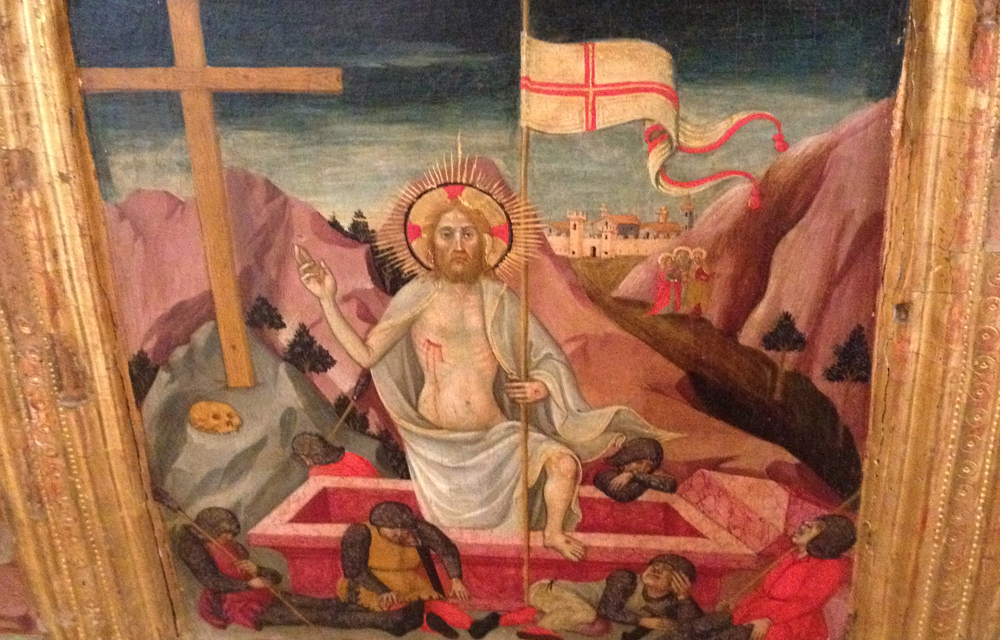RESURRECTION SYMBOLISM
The earliest Christian images use symbols such as the one at right to express the intimate connection between the Crucifixion and the Resurrection. In the picture, the chi-rho within the wreath represents the crucified Christ while the wreath and birds represent his victory over death. For further discussion and examples of this iconographic type, see my page on the Crucifixion.THE DESCENT INTO HELL
Orthodox churches handle the Resurrection by showing Christ coming to Hell and rescuing the patriarchs and prophets. Images of this kind are called the Anastasis, which is simply Greek for "Resurrection." For further discussion and examples of this iconographic type, see my page on the Descent into Hell.THE THREE WOMEN AT THE TOMB
This type goes back to at least the 6th century and is based on the synoptic Gospels' account of the women who first arrived at the tomb. The tomb had been "hewed out in a rock" and donated by Joseph of Arimathea, who had "rolled a stone to the door" (Mark 15:46). But when the women arrived the stone had been rolled away and they were told that Jesus had risen.The names and number of the women vary from one gospel to the next, but most artists have chosen to follow Mark, who says there were three. As in Mark and Luke, they always carry spice jars to anoint the body (example). One historiated capital from late 12th-century Catalonia even adds a scene in which they buy the spices from a man in a shop. The sculpture may have been influenced by a similar scene in The Easter Verses of the Three Maries, a Catalan play from the early 12th century (Dronke, 92-95).
In Matthew the good news is announced to them by a young man sitting outside on the stone, but in Mark the man is inside, "sitting on the right." In the Catena one commentator explains that "we need not wonder, for they afterwards saw sitting within…the same angel as sat without" (II, 336). In early images he sits outside a little round temple of classical design and greets just two women (example). The
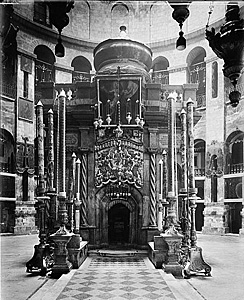
The young man himself is almost invariably pictured as an angel with wings (example, exception). In one striking example the wings are on his head, as in classical images of the god Mercury. Most images have him point to somewhere outside the frame in order to register his words to the women, "behold the place where they laid him" or possibly his command, "going quickly, tell ye his disciples that he is risen" (example).1 Some images follow Luke in placing two men in the tomb rather than one (example).
Surprisingly, few images do much to render Matthew's statement that the man's "countenance was as lightning, and his raiment as snow" despite the commentators' enthusiastic embrace of this detail. "That robe is not from mortal fleece," says St. Gregory, for example, "but of living virtue, blazing with heavenly light."2
In Matthew Jesus greets the women while they are running from the tomb to inform the disciples. They embrace his feet and adore him. This is pictured in a 6th-century manuscript and also, Fuchs argues, on the 4th-century Sarcophagus of Jonah, which is itself a grand meditation on the topic of Resurrection.
CHRIST EMERGING FROM THE SARCOPHAGUS
According to Mâle (194, n. 1) there are a few 12th-century examples of this next type of Resurrection image, but it became widespread only in the 13th and is probably the one most familiar to modern viewers. Despite scripture's silence on the matter, this iconography has Christ stepping forth from a sarcophagus in triumph, as in the image at the top of this page. One hand will hold a long cross or a standard with a banner. Often the banner has a red cross on a white field. He raises his other hand in greeting or triumph, either palm-out or with the fingers in the blessing configuration. Sometimes the lid of the sarcophagus lies on the ground. Despite the clear impression left by the gospels that the sarcophagus was inside a tomb, many are like the picture at the top of this page in putting the event in an outdoor setting.Many images show just Christ emergent, without the soldiers (example). When the soldiers are included, typically one will be reacting in fear to what he sees while the others lie around the sarcophagus with their eyes closed. This corresponds to Matthew 28:4, "And for fear of him, the guards were struck with terror, and became as dead men" and Jerome's gloss, "The guards lay like dead men in a trance of terror" (example).3
Tintoretto's versions of this Resurrection type have Christ flying up from the sarcophagus, his feet in the air (example). This device influenced Aliense's Resurrection paintings in Venice (example), Palma il Giovane's Descent into Limbo, and perhaps even this parchment from Rome.
A stained-glass window in Canterbury has the familiar figure of Christ stepping out as if from a sarcophagus, but instead from a brick monumentum.
THE APPEARANCE TO MARY MAGDALENE
In John's gospel, Jesus appears first to Mary Magdalene. At first she thinks he is a gardener, but then she recognizes him and says Rabboni ("Master"). In the Latin Vulgate he replies Noli me tangere, "Do not touch me, for I am not yet ascended to my Father."4 The images express the Rabboni by showing Mary kneeling, as in the picture below, or making a low bow, as in this relief. To represent the "Do not touch me," Jesus gestures with his right hand while Mary touches or nearly touches his garment, as here: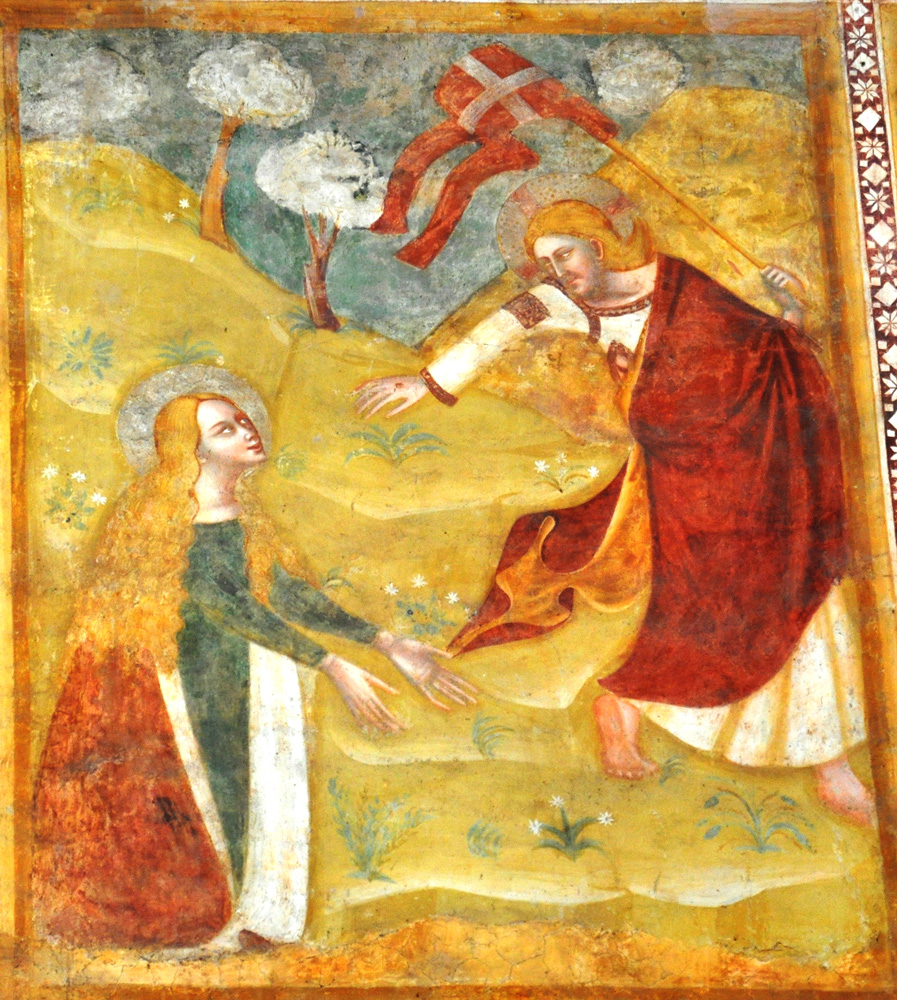
Mary represents all repentant sinners. Indeed, he willed to appear first to her for five reasons. The first, that she loved him more ardently; Luke 7:47: "Many sins are forgiven her because she loved much." The second, in order to show that he had died for sinners; Matt. 9:13: "I came not to call the just but sinners." The third, because harlots go ahead of the wise in the kingdom of heaven; Matt. 21:31: "The harlots will go into the kingdom of God before you." The fourth, that as a woman had been the messenger of death, so a woman should be the one to announce life: this according to the Gloss. The fifth, that where sin abounded, grace would superabound, as we read in Rom. 5:20 (Ryan, I, 220).A great many of the images emphasize that this first apparition took place in a garden, by filling in the background with flowers and/or trees, as in the picture above and the one below. Some even give Jesus a shovel and other gardening implements (example). This may be due to the suggestion of St. Gregory cited in the Catena Aurea:
Perhaps, however, the woman was right in believing Jesus to be the gardener. Was not He the spiritual Gardener, who by the power of His love had sown strong seeds of virtue in her breast? (IV, ii, 601-602, from Homilies, xxv)
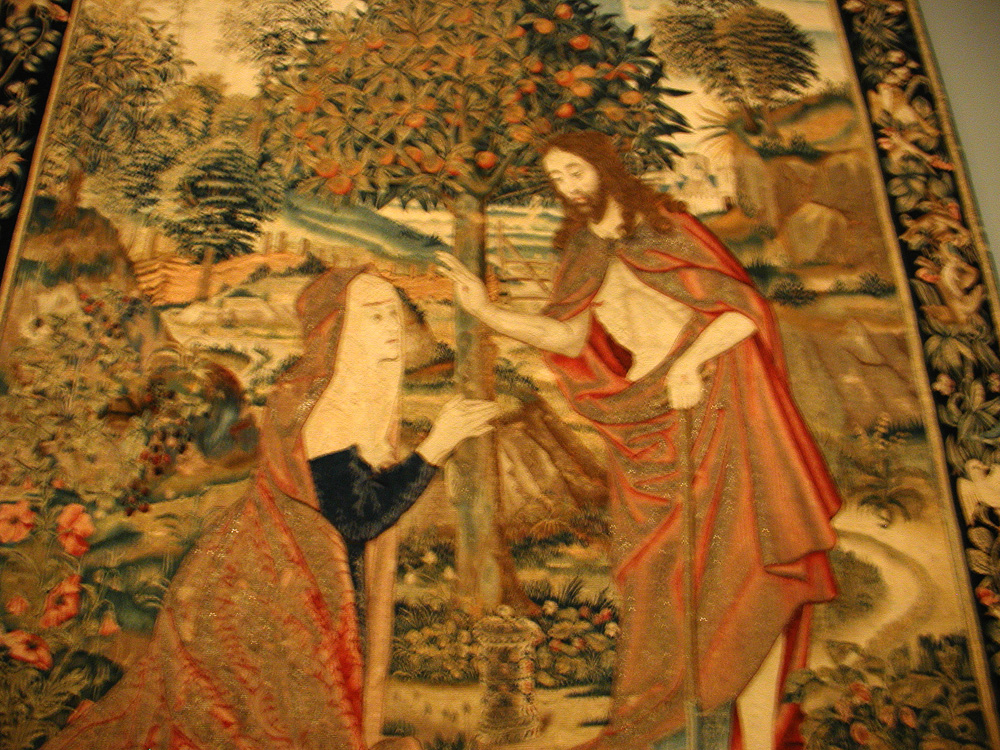
EMMAUS
In Luke 24 Jesus appears to two of his disciples as they are walking from Jerusalem to a nearby village called Emmaus. For a study of Emmaus images, please follow this link.
Prepared in 2016 by Richard Stracke, Emeritus Professor of English, Augusta University. Revised 2016-09-10, 2021-11-11.
HOME PAGE
Detail from a predella in the Ducal Palace, Urbino. See the description page.
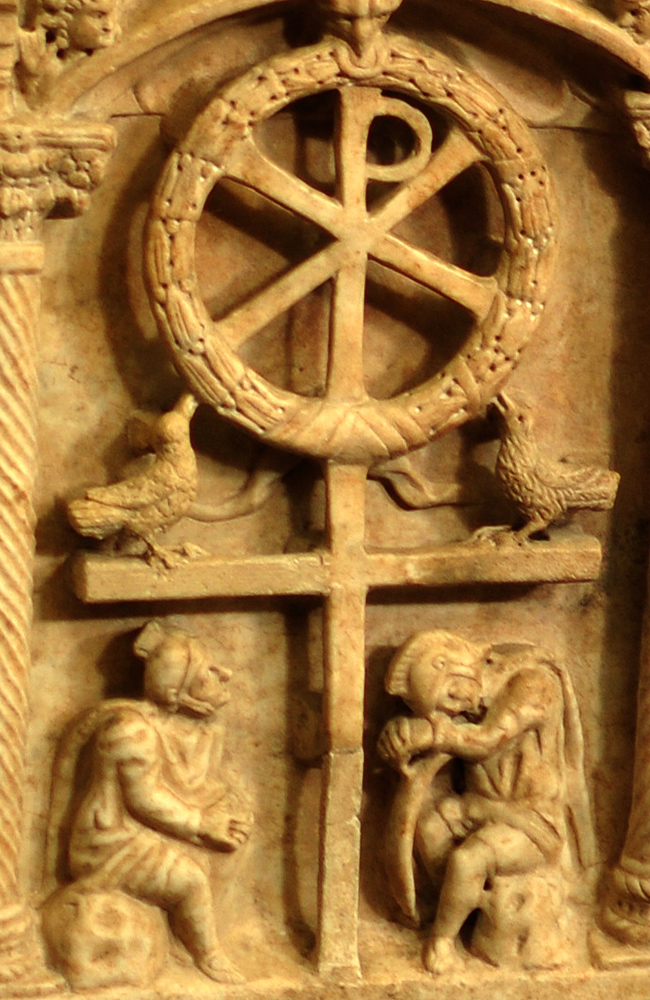
Detail from the Sarcophagus of Domatilla , 4th century – See the description page
MATTHEW 28:1-10 — And in the end of the sabbath, when it began to dawn towards the first day of the week, came Mary Magdalen and the other Mary, to see the sepulchre. 2And behold there was a great earthquake. For an angel of the Lord descended from heaven, and coming, rolled back the stone, and sat upon it. 3And his countenance was as lightning, and his raiment as snow. 4And for fear of him, the guards were struck with terror, and became as dead men. 5And the angel answering, said to the women: Fear not you; for I know that you seek Jesus who was crucified. 6He is not here, for he is risen, as he said. Come, and see the place where the Lord was laid. 7And going quickly, tell ye his disciples that he is risen: and behold he will go before you into Galilee; there you shall see him. Lo, I have foretold it to you. 8And they went out quickly from the sepulchre with fear and great joy, running to tell his disciples. 9And behold Jesus met them, saying: All hail. But they came up and took hold of his feet, and adored him. 10Then Jesus said to them: Fear not. Go, tell my brethren that they go into Galilee, there they shall see me.
Mark 16:1-7 And when the sabbath was past, Mary Magdalen, and Mary the mother of James, and Salome, bought sweet spices, that coming, they might anoint Jesus. 2And very early in the morning, the first day of the week, they come to the sepulchre, the sun being now risen. 3And they said one to another: Who shall roll us back the stone from the door of the sepulchre? 4And looking, they saw the stone rolled back. For it was very great. 5And entering into the sepulchre, they saw a young man sitting on the right side, clothed with a white robe: and they were astonished. 6Who saith to them: Be not affrighted; you seek Jesus of Nazareth, who was crucified: he is risen, he is not here, behold the place where they laid him. 7But go, tell his disciples and Peter that he goeth before you into Galilee; there you shall see him, as he told you.
John 20:1-18 And on the first day of the week, Mary Magdalen cometh early, when it was yet dark, unto the sepulchre; and she saw the stone taken away from the sepulchre. 2She ran, therefore, and cometh to Simon Peter, and to the other disciple whom Jesus loved, and saith to them: They have taken away the Lord out of the sepulchre, and we know not where they have laid him. 3Peter therefore went out, and that other disciple, and they came to the sepulchre. 4And they both ran together, and that other disciple did outrun Peter, and came first to the sepulchre. 5And when he stooped down, he saw the linen cloths lying; but yet he went not in. 6Then cometh Simon Peter, following him, and went into the sepulchre, and saw the linen cloths lying, 7And the napkin that had been about his head, not lying with the linen cloths, but apart, wrapped up into one place. 8Then that other disciple also went in, who came first to the sepulchre: and he saw, and believed. 9For as yet they knew not the scripture, that he must rise again from the dead. 10The disciples therefore departed again to their home. 11But Mary stood at the sepulchre without, weeping. Now as she was weeping, she stooped down, and looked into the sepulchre, 12And she saw two angels in white, sitting, one at the head, and one at the feet, where the body of Jesus had been laid. 13They say to her: Woman, why weepest thou? She saith to them: Because they have taken away my Lord; and I know not where they have laid him. 14When she had thus said, she turned herself back, and saw Jesus standing; and she knew not that it was Jesus. 15Jesus saith to her: Woman, why weepest thou? whom seekest thou? She, thinking it was the gardener, saith to him: Sir, if thou hast taken him hence, tell me where thou hast laid him, and I will take him away. 16Jesus saith to her: Mary. She turning, saith to him: Rabboni (which is to say, Master). 17Jesus saith to her: Do not touch me, for I am not yet ascended to my Father. But go to my brethren, and say to them: I ascend to my Father and to your Father, to my God and your God. 18Mary Magdalen cometh, and telleth the disciples: I have seen the Lord, and these things he said to me.
MORE IMAGES
- 5th century: In this panel in an ivory diptych, the angel speaks with Mary Magdalene at a tomb that is pictured as a tiny temple with steps.
- 6th century: In this detail on a reliquary box the two women of Matthew 28 visit a tomb modeled on the Aedicula.
- 11th century: The right side of the "Latin Diptych" in the museum of Milan's cathedral pictures the visit of the two Marys to the tomb, Christ's appearance to the apostles in Jerusalem, and the "doubting Thomas" narrative.
- 12th century: Ivory plaque with the Emmaus apparition above and the Noli me tangere below (with just Christ and Mary Magdalene, no garden or other background).
- 1160-1180: The Anastasis is the tenth of the ten panels outlining the Life of Christ on a German portable altar.
- 13th century: This Noli Me Tangere, ascribed by some to Giotto, includes the two angels that Mary Magdalene saw inside the tomb. Christ holds a shovel or hoe.
- 1280-85: The great central tympanum on the façade of Strasbourg Cathedral represents the Resurrection with a sequence of three scenes: the Harrowing of Hell, the appearance to Mary Magdalen, and doubting Thomas.
- 1303-1305: Giotto's Noli me tangere for the Scrovegni Chapel focuses on the Resurrection event more than on the relation between the two figures.
- 1344: Detail from Guariento di Arpo's Coronation of the Virgin altarpiece.
- 15th century: Inside the right door of an altarpiece in Salamanca Christ stands with the banner in a mandala on his sarcophagus.
- 1440s: Fra Angelico's Noli Me Tangere in a Franciscan friar's cell.
- 1443: In Vivarini's Polyptych of the Body of Christ The two Marys of Matthew 28:1 are added to the traditional "rising from the sarcophagus" scene.
- Late medieval: Detail from a predella in Croatia.
- 1508: Resurrection in a Capital B: Christ emerging from the sarcophagus.
- 1513-14: At the summit of the Costabili Polyptych
- 1547-51: A detail in the main altarpiece at Cáceres Cathedral.
- After 1579: Cesare Nebbia's Noli me tangere, with Christ as a gardener.
- 1882: Stained glass window of Christ emerging from the sarcophagus. Includes the angel that rolled the stone away.
- 20th century: This santo of the resurrected Christ in Cuilapan and this one from Teotitlán are typical of many found in Mexico. Dressed in garments of contemporary fabric, some are centuries old.
- Mid-20th century: A stained glass window in an Anglican church has one panel for the noli me tangere and two others for the Emmaus account.
- 21st century: Bronze door at Santa Maria degli Angeli, Rome.
- Undated (17th century?): This painting abandons traditional iconography in order to emphasize Christ's victory over Sin and Death.
- The Apparition on the Road to Emmaus
- The Mary Magdalene page
- The Descent into Hell
- The Sarcophagus of Jonah
ALSO SEE
COMMENTARIES
NOTES
1 Mark 16:6,7; Matthew 28:6,7.
2 Matthew 28:3, Catena, II, 337. Mark (16:5) says only that the garment was white. In Luke (24:4) there are two men, "in shining apparel."
3 Catena Aurea, I, iii, 979.
4 Norris, 116 et pass.
4 For "do not touch me" the original Greek actually has μη μου απτου, whose meaning modern translators take to be closer to "do not take hold of me." However, artists in the medieval West knew only the Latin noli me tangere and so picture Jesus gesturing against Mary Magdalene's touch. See Olszewski, 18.
